An advantage of sled dogs (or bunnies) is, as you travel, they can be fed off the land. And a dog team’s food is compact (fish, game, the odd belligerent moose packaged neatly in small bundles) compared to the bales of fodder a horse needs (an average horse needs half a bale of hay a day, a bale can be forty or fifty pounds). Rabbits would be able to eat off the land too. Though if you were travelling a long distance, you’d have to turn them loose to eat, as their fodder would, like the horses’, take up a lot of space.
Another advantage: they’re light as Legolas. A dog’s footprint is, much like an Elf’s, quite light on snow. Rabbits too, are light of foot. The snowshoe hare is particularly suited to running over deep snow.
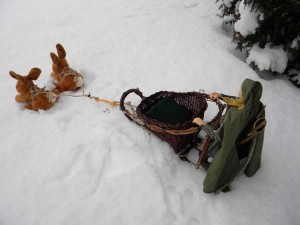 Radagast is not riding the runners like a modern musher. He’s standing on a platform. His sled seems to be a combination of a modern dogsled and the sort of Native sleds I saw in Fast Runner; a platform with runners, (with brush bow and driving bow like a modern sled). On the traditional Native sled, you’d run alongside your dogs, or run and jump on and sit on the sled with your hunting gear or the dead seal. Another historic design used into the twentieth century; ** “…most every sled at the turn of the twentieth century was equipped with a “gee pole.” The gee pole was a stout pole lashed to, and projecting from, the front of the sled, which the sled driver could use to leverage and steer the sled. Most dog drivers still did not ride the sled, instead running beside or riding skis or a sort of early snowboard between the dog team and sled. Riding the sled-runners was used only by drivers of light and fast mail and race teams.”
Radagast is not riding the runners like a modern musher. He’s standing on a platform. His sled seems to be a combination of a modern dogsled and the sort of Native sleds I saw in Fast Runner; a platform with runners, (with brush bow and driving bow like a modern sled). On the traditional Native sled, you’d run alongside your dogs, or run and jump on and sit on the sled with your hunting gear or the dead seal. Another historic design used into the twentieth century; ** “…most every sled at the turn of the twentieth century was equipped with a “gee pole.” The gee pole was a stout pole lashed to, and projecting from, the front of the sled, which the sled driver could use to leverage and steer the sled. Most dog drivers still did not ride the sled, instead running beside or riding skis or a sort of early snowboard between the dog team and sled. Riding the sled-runners was used only by drivers of light and fast mail and race teams.”
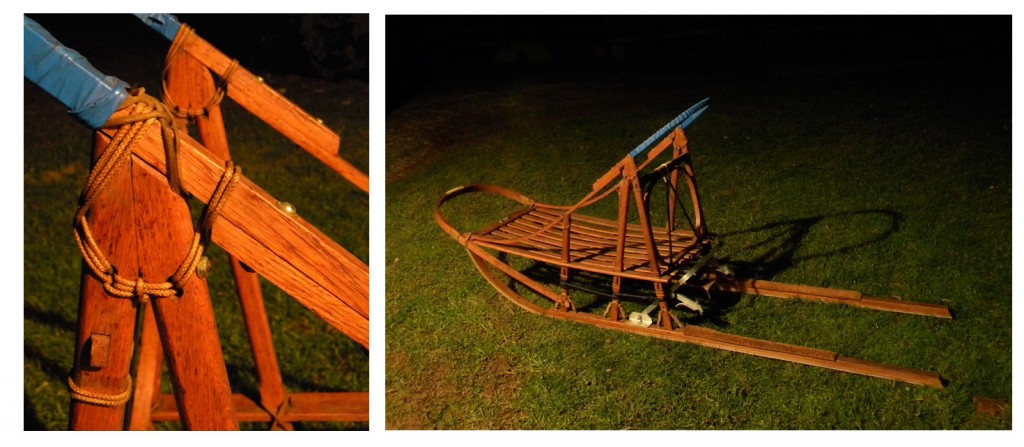 Is that action for real? Radagast has a death grip on the driving bow on his sled, and is leaning and swerving and using body language much like I would expect. A sled doesn’t steer: you kind of launch it around with your body weight, and your dogs (or bunnies) pull it around corners. This is why your strongest dogs are the wheel dogs, right in front of the sled. They do most of the work going around a corner. A sled is quite flexible; the best ones are lashed together, not bolted, the runners can be flexed and warped with your feet. This is a design that would be easy for Radagast to build, surrounded by branches and twigs and vines. Riding a sled is like being on skis with a handle. (A kicksled is just that: skis and a driving bow, designed for use without dogs, a standard sled looks like the picture above, you can carry gear on it). Radagast’s platform thingie (and the keel down the center) would cut down the flexibility of his sled. If you thought the sledbunny action was a bit exaggerated, watch some sprint racing mushing videos, or ski-joring. There is lots of leaping and crouching and swerving and general mayhem… for the mushers, at least. Dogs (like rabbits) are quite agile and capable of keeping out of the gangline and scrambling over obstacles. And only dogs that enjoy doing this are chosen for the teams.
Is that action for real? Radagast has a death grip on the driving bow on his sled, and is leaning and swerving and using body language much like I would expect. A sled doesn’t steer: you kind of launch it around with your body weight, and your dogs (or bunnies) pull it around corners. This is why your strongest dogs are the wheel dogs, right in front of the sled. They do most of the work going around a corner. A sled is quite flexible; the best ones are lashed together, not bolted, the runners can be flexed and warped with your feet. This is a design that would be easy for Radagast to build, surrounded by branches and twigs and vines. Riding a sled is like being on skis with a handle. (A kicksled is just that: skis and a driving bow, designed for use without dogs, a standard sled looks like the picture above, you can carry gear on it). Radagast’s platform thingie (and the keel down the center) would cut down the flexibility of his sled. If you thought the sledbunny action was a bit exaggerated, watch some sprint racing mushing videos, or ski-joring. There is lots of leaping and crouching and swerving and general mayhem… for the mushers, at least. Dogs (like rabbits) are quite agile and capable of keeping out of the gangline and scrambling over obstacles. And only dogs that enjoy doing this are chosen for the teams.
 Radagast is using some random sort of bunny harness that looks more like what I’d use to walk my dog, rather than a sledding harness, (at least, as far as I can tell in watching it three times, once in HFR). The X-back or siwash is the standard for today’s musher, though there are lots of other designs, including the “how we won Alaska” horse-collar style of the 1800’s. The siwash is one piece without buckles or adjustments: easy to make if you are a hermit living in the woods with no forge or Dwarves (to make hardware) nearby. I have used a walking harness on the Hobbit Husky (Max the Schipperke,16 pounds) because I did not yet have an X-back for him (he got a custom made one later). It worked, but he was mostly just trotting along with the big dogs, not pulling hard. I note that Radagast is not using necklines (from the collars of the dogs to the gangline) to keep his bunnies in line, perhaps because of their enthusiastic rabbity leaping gait, and their need to go over lots of woodland obstacles. I have read the blogs of professional mushers who, in some circumstances, also do not use necklines (gives the dogs more freedom of movement, and the ability to pick a path around obstacles). I use necklines because I am going down a fairly straight rail trail, or park trail, and when Dog#1 is yawing to starboard going “SQUIRREL!”, Dog#2 is still going straight forward and hauls Dog#1 along with her. Dogs 3 and 4 might be going some other direction.
Radagast is using some random sort of bunny harness that looks more like what I’d use to walk my dog, rather than a sledding harness, (at least, as far as I can tell in watching it three times, once in HFR). The X-back or siwash is the standard for today’s musher, though there are lots of other designs, including the “how we won Alaska” horse-collar style of the 1800’s. The siwash is one piece without buckles or adjustments: easy to make if you are a hermit living in the woods with no forge or Dwarves (to make hardware) nearby. I have used a walking harness on the Hobbit Husky (Max the Schipperke,16 pounds) because I did not yet have an X-back for him (he got a custom made one later). It worked, but he was mostly just trotting along with the big dogs, not pulling hard. I note that Radagast is not using necklines (from the collars of the dogs to the gangline) to keep his bunnies in line, perhaps because of their enthusiastic rabbity leaping gait, and their need to go over lots of woodland obstacles. I have read the blogs of professional mushers who, in some circumstances, also do not use necklines (gives the dogs more freedom of movement, and the ability to pick a path around obstacles). I use necklines because I am going down a fairly straight rail trail, or park trail, and when Dog#1 is yawing to starboard going “SQUIRREL!”, Dog#2 is still going straight forward and hauls Dog#1 along with her. Dogs 3 and 4 might be going some other direction.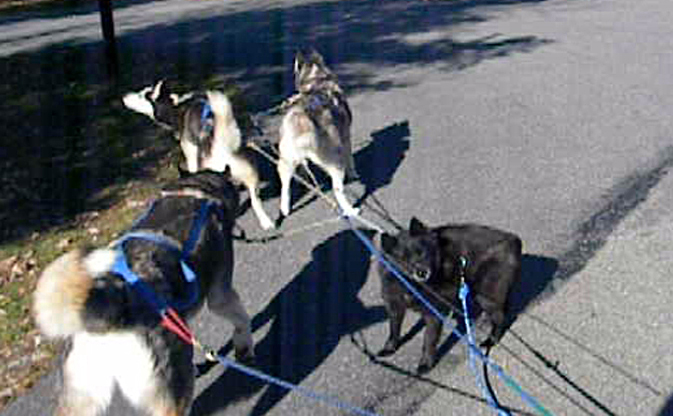
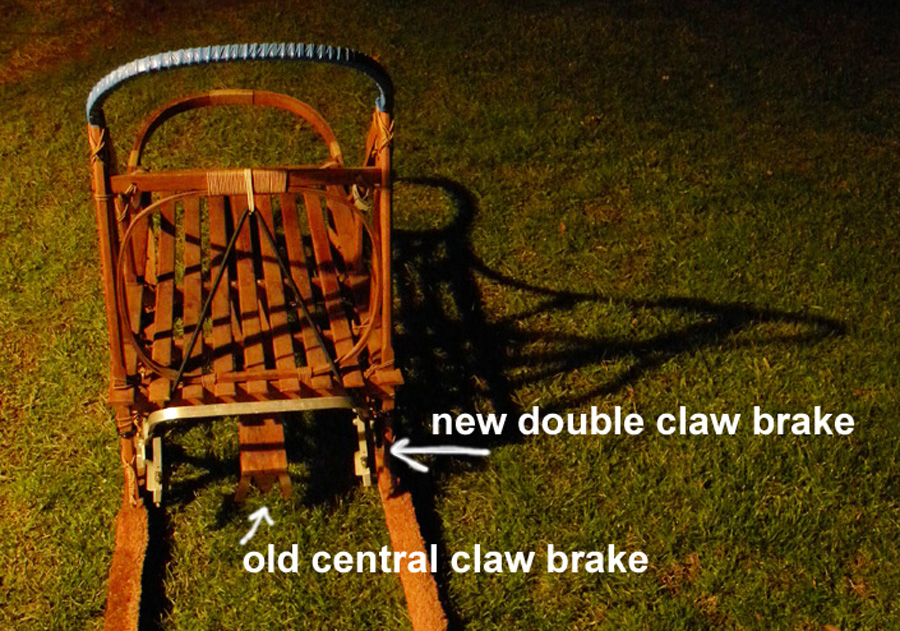 Radagast appears to not have brakes. Holeycrappoly! There is a claw brake beneath a sled, which you step on to stop as you shriek whoa!, which the dogs are ignoring. Often, there is also, ironically, a piece of snowmobile track dangling between your runners. You step on this to slow the team down. You can also just throw the whole sled over on its side to stop… mostly stop… depending on how big your team is. You set a snowhook when you get off the sled (like an anchor) or tie the whole mess to a tree or two. Radagast doesn’t have a snowhook either. I was howling when the bunnies take off and he is running to catch up to the sled. Been there, done that. Which is why I run with a safety line attached to my leaders. And a quick release so I don’t get dragged if I do fall off.
Radagast appears to not have brakes. Holeycrappoly! There is a claw brake beneath a sled, which you step on to stop as you shriek whoa!, which the dogs are ignoring. Often, there is also, ironically, a piece of snowmobile track dangling between your runners. You step on this to slow the team down. You can also just throw the whole sled over on its side to stop… mostly stop… depending on how big your team is. You set a snowhook when you get off the sled (like an anchor) or tie the whole mess to a tree or two. Radagast doesn’t have a snowhook either. I was howling when the bunnies take off and he is running to catch up to the sled. Been there, done that. Which is why I run with a safety line attached to my leaders. And a quick release so I don’t get dragged if I do fall off.
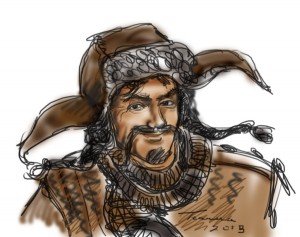 Bofur and Radagast seem to shop at the same hat emporium. Both hats look like the sort of thing you might find on the head of a musher in the far reaches of Alaska. A brief google search reveals that hats of this sort were used by everyone freezing their ears off from Russia (where it is called a ushanka) to Germany to Scandinavia to the Mongols and Scythians. Besides keeping your head warm, it offers some protection from blows to the head from falling on ice… or being nailed by orcs.
Bofur and Radagast seem to shop at the same hat emporium. Both hats look like the sort of thing you might find on the head of a musher in the far reaches of Alaska. A brief google search reveals that hats of this sort were used by everyone freezing their ears off from Russia (where it is called a ushanka) to Germany to Scandinavia to the Mongols and Scythians. Besides keeping your head warm, it offers some protection from blows to the head from falling on ice… or being nailed by orcs.
You don’t need to live in the Frozen North to enjoy the fine art of mushing. All you need is what you probably already have: a dog and a bike, or skateboard, or rollerblades, or snowboard. A sledding harness is cheap, training is easy and fun, and it’s a great way to get outside and amuse your dog.
Don’t forget to wear a helmet. Or steal Bofur’s hat.
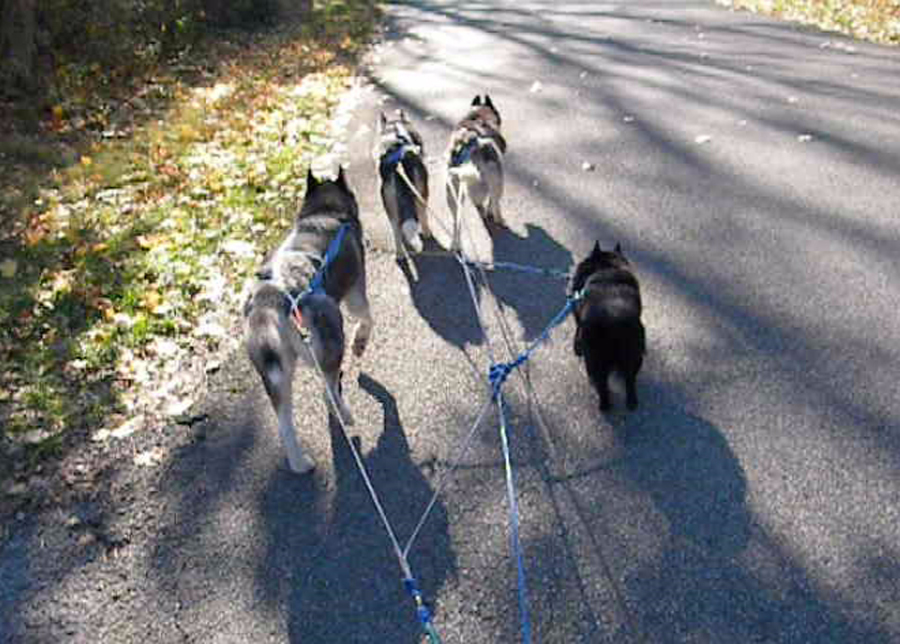 Commands: Unlike driving horses, you do not use reins, only voice commands. You do not say mush to start your team, (you shout “hike!”, or scream “waaaaaaaaaaaaaaiiiiiiit, I’m not ready yeeeeeeeeeet!!!!”) Mush comes from a French word; “Marche!” to go, run. The French coureurs des bois and the voyageurs were the first Europeans in the Canadian Shield, so established many of the mushing traditions. The English speaking Canadians mangled it nicely into mush. We linguistically-impaired Americans adopted that. You say “gee” to turn right, “haw” to turn left, and “whoa” to stop. Then you converse like a mariner because your dogs are not stopping. Then you throw the sled over on its side. Or run into a tree and explain later that you were clobbered by an ent.
Commands: Unlike driving horses, you do not use reins, only voice commands. You do not say mush to start your team, (you shout “hike!”, or scream “waaaaaaaaaaaaaaiiiiiiit, I’m not ready yeeeeeeeeeet!!!!”) Mush comes from a French word; “Marche!” to go, run. The French coureurs des bois and the voyageurs were the first Europeans in the Canadian Shield, so established many of the mushing traditions. The English speaking Canadians mangled it nicely into mush. We linguistically-impaired Americans adopted that. You say “gee” to turn right, “haw” to turn left, and “whoa” to stop. Then you converse like a mariner because your dogs are not stopping. Then you throw the sled over on its side. Or run into a tree and explain later that you were clobbered by an ent.
On-by, and ON-BY!!! (expletive deleted) are used when Radagast passes you on the trail and your dogs attempt to eat the rabbits.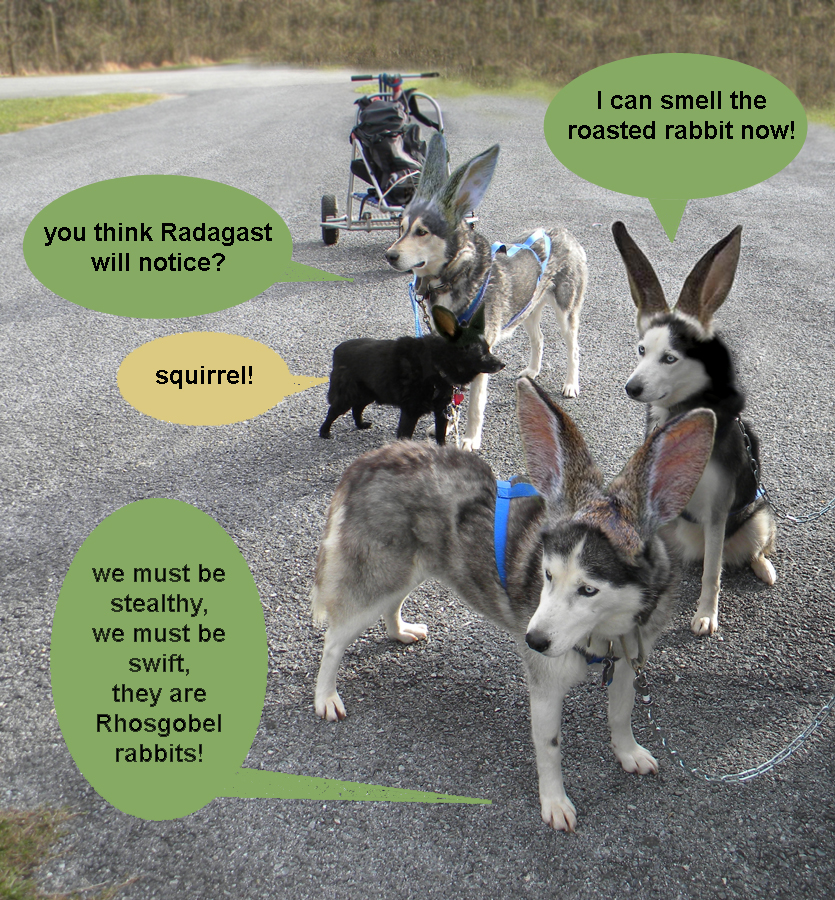
The Hobbit was a read-aloud tale, in the ancient oral tradition. It’s much less serious than LOTR. There’s lots of room for quirkiness. I quite like the quirkiness. Some may differ on that subject. Oh well.
Happy mushing Radagast! Can’t wait to get the action figure!
Teanna Byerts, aka: swordwhale
Teanne Byerts (swordwhale) is a member of our Message Boards who has been a Recreational Musher since 1996. If you’re interested in knowing more about Mushing you can visit her website here. The views in this article are her own, and do not necessarily represent those of TheOneRing.net or its staff.
**some random north country mushing history from http://www.blm.gov/ak/st/en/prog/nlcs/iditarod/history/people/mush_hist.html


